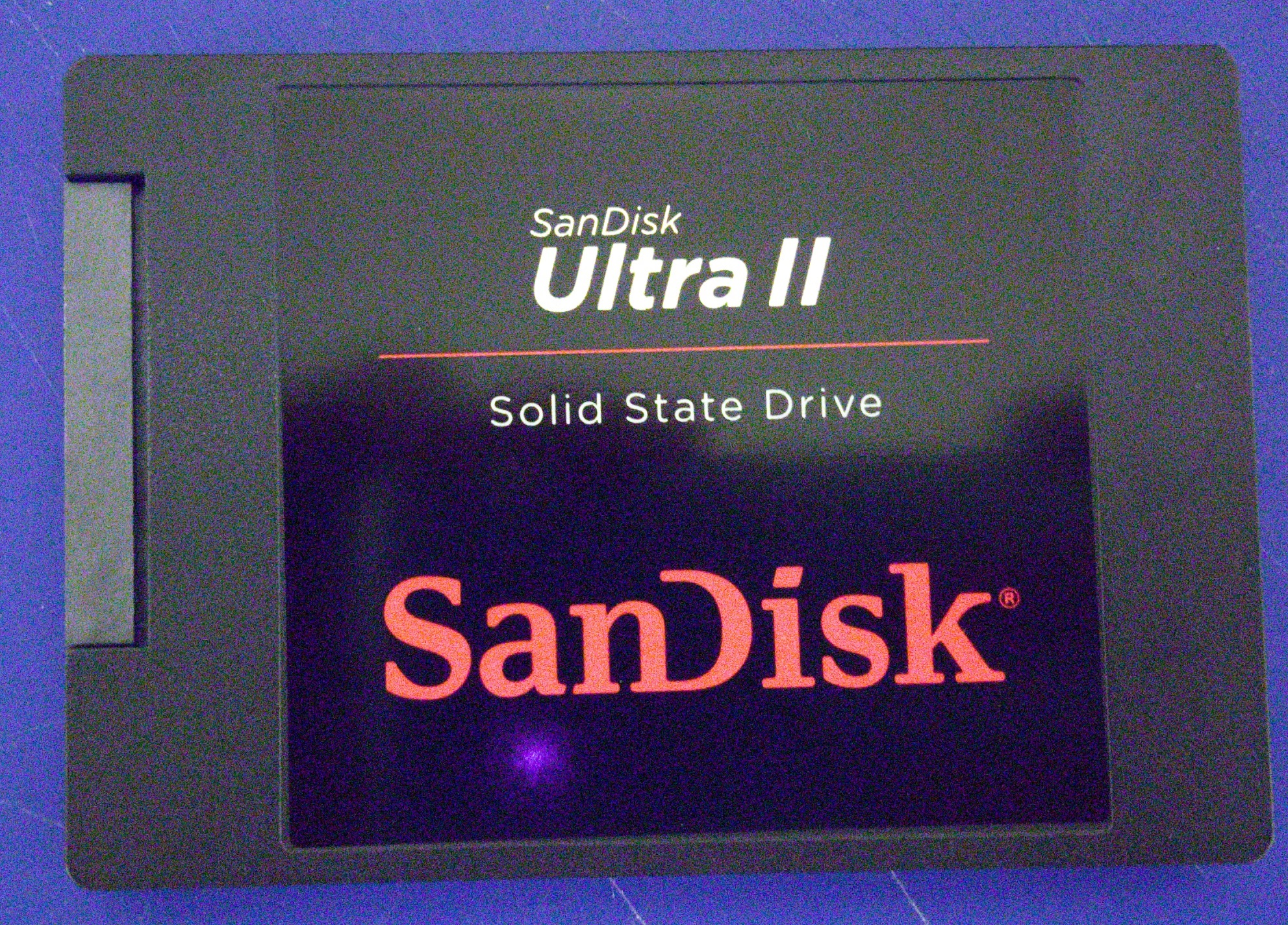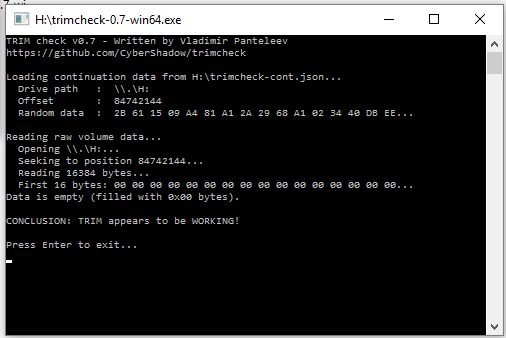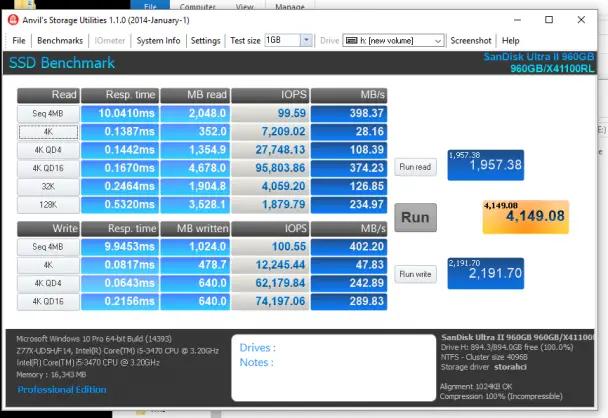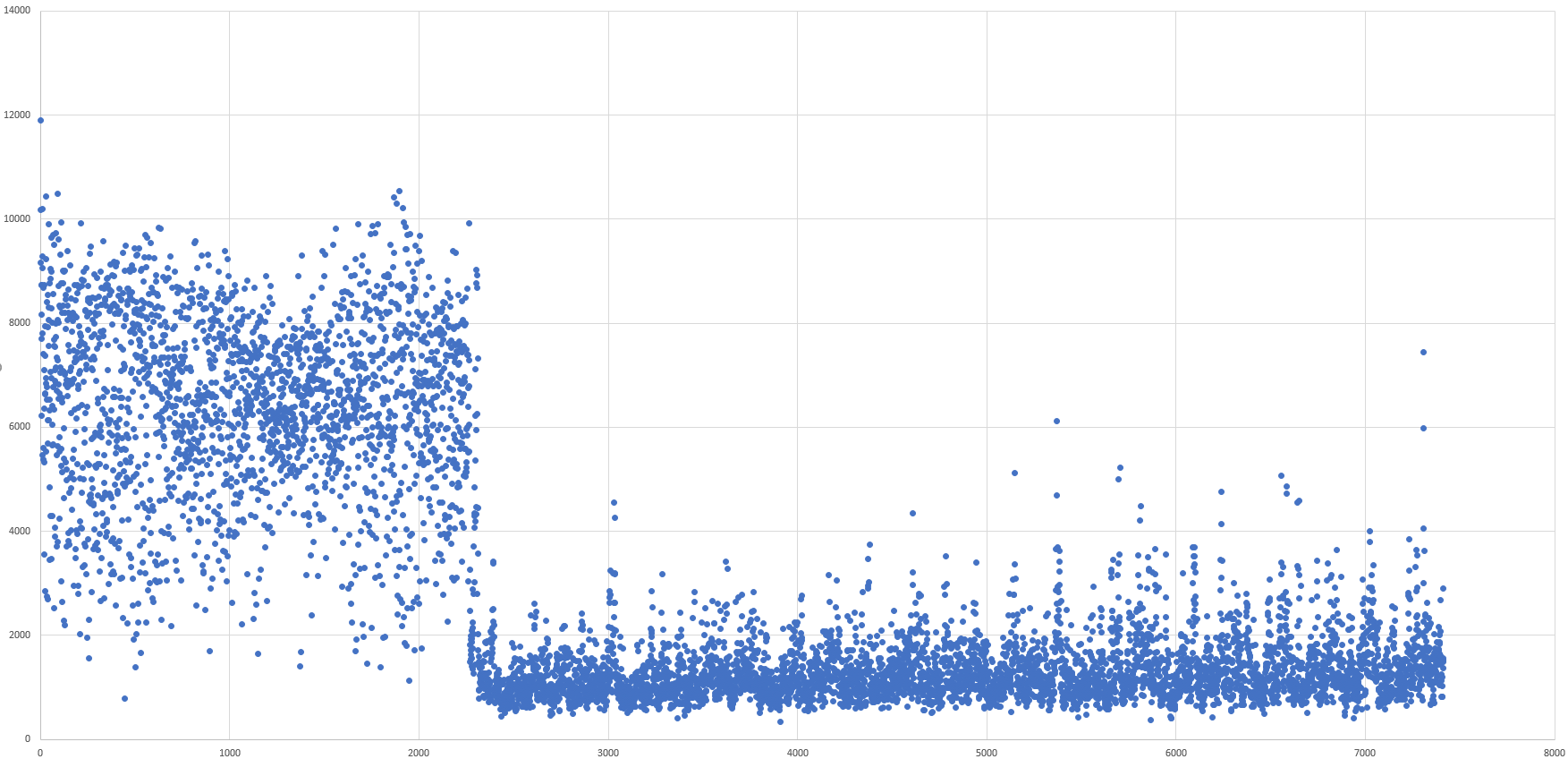Sandisk Ultra II 1Tb Review
Sandisk’s Ultra II is the first Terabyte class SSD we’ve had a chance to review. It also made a splash when it was first released as the first TLC drive not released by Samsung. First introduced in late 2014 lets see how this drive has aged.
Our Test System and Procedure
 Our test system isn’t going to set any records for cpu capability but it’s sufficiently equipped for SATA based ssd testing, the platform is a gigabyte Z77 motherboard equipped with an i5-3470, The Intel SATA6 ports are used in testing both as they offer consistently impressive performance regardless of generation as well as being the most commonly available port for most users. The system is running windows 10 Professional and was under no load(AV disabled) for all tests. Testing will consist of ATTO first as it’s the manufacture stated test method for their numbers and then crystal disk mark to set expectations for rest of the tests which will consist of Anvil, AS SSD, PCmark and a custom IOmeter consistency test. The Test system was recently upgraded with both a hot swap bay for faster testing as well as a bump to 16Gb of ram.
Our test system isn’t going to set any records for cpu capability but it’s sufficiently equipped for SATA based ssd testing, the platform is a gigabyte Z77 motherboard equipped with an i5-3470, The Intel SATA6 ports are used in testing both as they offer consistently impressive performance regardless of generation as well as being the most commonly available port for most users. The system is running windows 10 Professional and was under no load(AV disabled) for all tests. Testing will consist of ATTO first as it’s the manufacture stated test method for their numbers and then crystal disk mark to set expectations for rest of the tests which will consist of Anvil, AS SSD, PCmark and a custom IOmeter consistency test. The Test system was recently upgraded with both a hot swap bay for faster testing as well as a bump to 16Gb of ram.
The Ultra II
The drive is packaged in an attractive cardboard box that manages to pack in a few accessories including a shim to increase the drive thickness. As a sidenote I’ve never actually had to install one of these if anyone has leave me a note in the comments i’m curious. Beyond that the included card directs you to SanDisk’s SSD dashboard which we’ll take a look at. Taking a look at the table below we can see SanDisk has some high performance aspirations for this drive with listed interface limited read speeds and a solid 500Mb/s write. Beyond that the 3 year warranty is par for the course although we don’t get a TBW rating for the drive to set any expectations for endurance, that said the drive still reads 100% endurance remaining post testing with 6TBW during testing.
| Capacity | 960GB |
|---|---|
| Controller | Marvell 88SS9189 |
| Firmware | X41310RL |
| NAND | SanDisk 2nd Gen 128Gbit 19nm TLC |
| Sequential Read | 550 MB/s |
| Sequential Write | 500 MB/s |
| 4k Random Read | 95,000 IOPS |
| 4k Random Write | 79,000 IOPS |
| Temperature range | 0-70°C |
| Dimensions | 7mm X 69.85mm X 100.5mm |
| Endurance | Unlisted (1.575million hour MTBF stated) |
| Warranty | 3 years |
Inside the Ultra II
Taking a look inside the Ultra II we see nand packages marked with SanDisk’s name(unfortunately illegible at this point). There’s a thermal pad that covers the entire board which is a good surprise, TLC memory uses more power and therefore produces more heat than MLC memory. The addition of this thermal pad should help ensure consistent performance. An additional note is that the increased density of the TLC memory allows the full 960gb on a single side of the PCB.
Sandisk SSD Dashboard
The main page presents the information most users are going to look for in capacity used and the health of the drive. We also see the drives firmware and model number listed prominently at the top(and visible under all pages) One feature I’m not a fan of is the use of part of the dashboard for advertising, it seems an odd choice as anyone here has already made the decision to purchase a SanDisk ssd.
Moving to the next section we see some performance information. Some users will appreciate the trim portion allowing them to regularly schedule the issuance of the trim command as opposed to relying on the OS to manage it. The Performance chart section is a bit disappointing even following sandisk’s direction to rebuild the windows performance indexes this appears non functional.
Next up is is an abundant selection of tools including S.M.A.R.T. information as well as secure erase options. The S.M.A.R.T. information does take a minute to load as it runs a test on demand. Most of the management options(sanitize, Secure Erase and PSID revert) require the creation of a flash drive to complete them as windows isn’t designed in such a way to allow that level of hardware access.
The settings contain some great features, email notifications are a huge plus if you were to deploy this in a remote system you needed information on to act proactively although over provisioning settings which I’ve seen in other manufacturer’s software(and have used to help even performance out) are missing. Beyond that are the standard “start with windows” options and the ability to check for updates. We’re going to pass over the help section as everything you need is in the title of that one.
ATTO
Like always we start off with ATTO Disk Benchmark, ATTO is provided by ATTO technology a designer of fiber channel and other high performance storage devices. We see uneven performance with a drop at the 256k. This odd stutter seems to be repeated at a few other transfer sizes although not quite to the same effect and was present across multiple test runs in an attempt to isolate the cause. We do see some impressive ~550MB/s reads at larger sizes(starting around 1Mb). This read is impressive and approaching the maximum theoretical speed of the SATA6 interface.
Trimcheck
Trim is a requirement for maintaining the performance of any modern SSD and informs a drive which blocks are no longer in use by the file system allowing them to be flushed during garbage collection, as SSD’s have program and erase as separate operations, this helps maintain performance by avoiding degradation as blocks are used. Fortunately most modern operating systems include support for this command as do most ssd’s at this point. As expected the Ultra II comes back with full support of the command ensuring consistent performance as it ages.
Crystal Disk Mark 5.1.2 x64
Up next we have Crystal Disk mark another canned benchmark and a very popular one, we use it in our reviews of lower performance memory products as it’s all inclusive for both sequential and random data. We run our tests using random (incompressible) data as some controllers(see sandforce) use compression to minimize writes and improve performance. We writes coming in lower than expected at 515MB/s at a queue depth of 32 and a competent write of 517MB/s sequentially at a queue depth of 1. Write speed appears only minorly impacted by queue depth moving from 414MB/s at QD1 to 423 at QD32. Looking back to ATTO we notice the sequential performance is fairly in line with it’s 128k transfer size which is unsurprising as that is the transfer size used by CDM for it’s sequential access patterns.
Anvil
Probably the single most comprehensive canned benchmark Anvil’s storage utilities which tests multiple queue depths and access types all with a single button press. Anvil paints an odd picture of the Ultra II, sequential numbers are lower than I expected coming in at 398.37 write and 402.20 read. Taking a peek back at atto it reported much more impressive numbers for the 4mb transfer size, however the drive is redeemed with an impressive showing in random performance. Overall performance although showing different strengths comes in at a good place for a sata drive.
AS SSD
AS SSD utilizes incompressible data exclusively in its testing and also reports access times, something missing from most of our other tests and these come back at an impressive.057 and .068 seconds for reads and writes respectively. The reported performance once again shows a bias towards read speed over write. AS SSD also includes a convenient file copy benchmark showing us what we can expect when moving a variety of data types around on the drive itself, these results are quite good showing a competent controller capable of handling mixed read/write scenarios.
PCmark8
PCmark 8 includes a variety of real world scenarios using predetermined runs of real world software of which it records the time required to complete them and reports them. Individual times are reported per application in addition these are all used to calculate a total throughput. The Ultra II scores 4915 posting expected performance for an SSD.
Consistency Test
Our custom consistency test bombards the drive with 4k random writes at a queue depth of 32 until it reaches what is referred to as “steady state” at this point we observe how the controller and nand act under their worst case scenario(dirty nand and no time to recover). This test is run for two hours which is more than sufficient to push a drive like the Ultra II into steady state. The results here are actually quite good especially considering the drives TLC memory. Unlike the Reactor where we saw a gradual decline as the memory all reached a dirty state we see somewhat haphazard performance bouncing between the promised rating and a more pedestrian 2000 iops at first. There are a few outliers above 100k iops and a few far below that 2000 but overall this is an impressive 30 minute run before finally reaching the more sustainable 500-1500 iops performance band. This sudden drop appears to be complete exhaustion of the drive’s SLC caching abilities. The duration (we’ll call it 2250 seconds) times the average data rate works out to about 56GB this is a bit more than the stated SLC cache size(40 gb), the Ultra II does have a memory folding mechanism that would attempt to free some of this as it was used however, we can actually see the result of this once we’ve reached steady state as spikes in performance periodically appearing.
Pricing and Final Thoughts
The Ultra II is the third(and not the last) SSD we’ve reviewed, at this point it’s difficult to draw too many conclusions overall but the drive has demonstrated far better performance than I expected which is a good thing! Performance for read heavy scenarios was generally good and the included software package although missing over provisioning was good overall, the notification feature especially will be welcome for some users. Pricing puts this drive in close competition with the Reactor we reviewed at the 1TB price with the 960Gb model coming in at 229.99 and a mount bundle offered for a few dollars more the 1Tb Reactor came in at 249.99 , Samsung’s 850 evo the current market leader however is now coming in at 324.99 this puts the Ultra II clearly as an excellent value offering good performance and at the 1TB size masking most of the shortcoming of TLC memory.








